Pengukuran paling akurat dari massa boson W menunjukkan tegangan dengan Model Standar.
Setelah 10 tahun melakukan analisis dan pengamatan yang cermat, ilmuwan CDF di Laboratorium Akselerator Nasional Fermi Departemen Energi AS mengumumkan pada 7 April 2022, bahwa mereka telah mencapai pengukuran paling akurat dari massa boson W, salah satu gaya alam- membawa partikel. Menggunakan data yang dikumpulkan oleh Fermilab’s Collider Detector, atau CDF, para ilmuwan kini telah menentukan massa partikel dengan akurasi 0,01% — dua kali akurasi pengukuran terbaik sebelumnya. Sesuai dengan gorila dengan berat 800 pon hingga 1,5 ons.
Skala presisi baru yang diterbitkan di majalah untuk mengetahui, memungkinkan para ilmuwan untuk menguji Model Standar fisika partikel, kerangka teoritis yang menggambarkan alam pada tingkat yang paling dasar. Hasilnya: Nilai massa baru menunjukkan ketegangan dengan nilai yang diperoleh para ilmuwan menggunakan input eksperimental dan teoretis dalam konteks Model Standar.
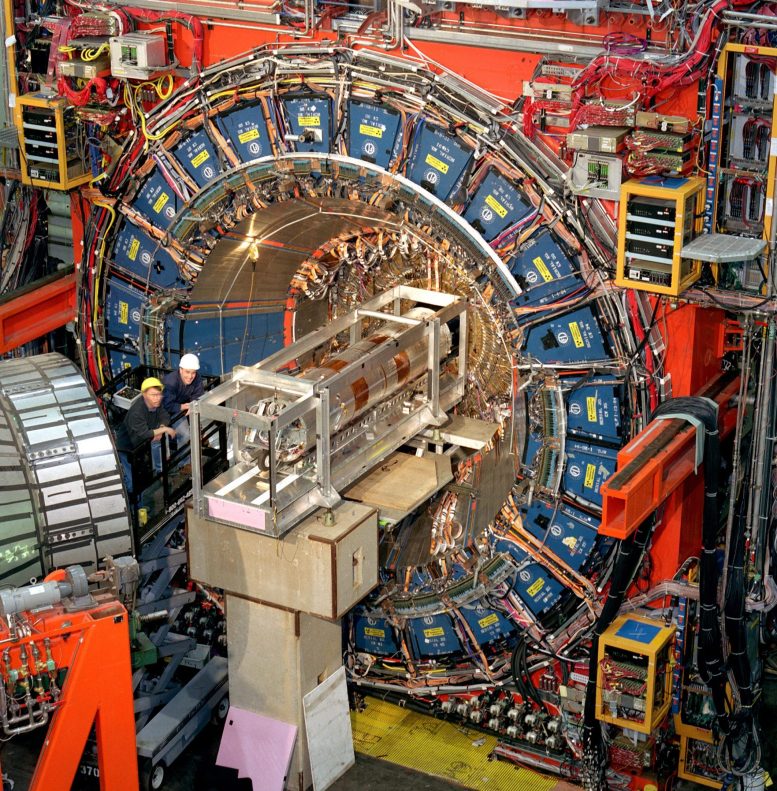
Detektor Collider Fermilab merekam tumbukan partikel berenergi tinggi yang dihasilkan oleh Tevatron Collider dari tahun 1985 hingga 2011. Sekitar 400 ilmuwan di 54 institusi di 23 negara masih mengerjakan banyak data yang dikumpulkan oleh eksperimen tersebut. Kredit: Fermilab
“Jumlah peningkatan dan validasi tambahan yang telah dilakukan untuk hasil kami sangat besar,” kata Ashutosh V. Kotwal dari Duke University, yang memimpin analisis ini dan merupakan salah satu dari 400 ilmuwan dalam kolaborasi CDF. “Kami memperhitungkan peningkatan pemahaman kami tentang detektor partikel kami serta kemajuan dalam pemahaman teoretis dan eksperimental tentang interaksi boson W dengan partikel lain. Ketika kami akhirnya mengungkapkan hasilnya, kami menemukan bahwa itu berbeda dari prediksi Model Standar. “
Jika dikonfirmasi, pengukuran ini menunjukkan potensi kebutuhan untuk perbaikan dengan mengorbankan Model Standar atau perluasan Model.
Para ilmuwan kini telah menentukan massa boson W dengan akurasi 0,01%. Ini adalah dua kali akurasi pengukuran terbaik sebelumnya dan menunjukkan ketegangan dengan model standar.
Nilai baru ini konsisten dengan banyak pengukuran massa boson W sebelumnya, tetapi ada juga beberapa perbedaan. Pengukuran di masa depan akan diperlukan untuk menjelaskan lebih banyak tentang hasilnya.
“Meskipun ini adalah hasil yang menarik, pengukuran harus dikonfirmasi oleh eksperimen lain sebelum dapat dijelaskan sepenuhnya,” kata Wakil Direktur Fermilab Joe Lykken.
Boson W adalah partikel pembawa pesan dari gaya nuklir lemah. Hal ini bertanggung jawab untuk proses nuklir yang membuat matahari bersinar dan molekul peluruhan. Menggunakan tumbukan partikel berenergi tinggi dari penumbuk Tevatron di Fermilab, kolaborasi CDF mengumpulkan sejumlah besar data yang mengandung boson W dari 1985 hingga 2011.
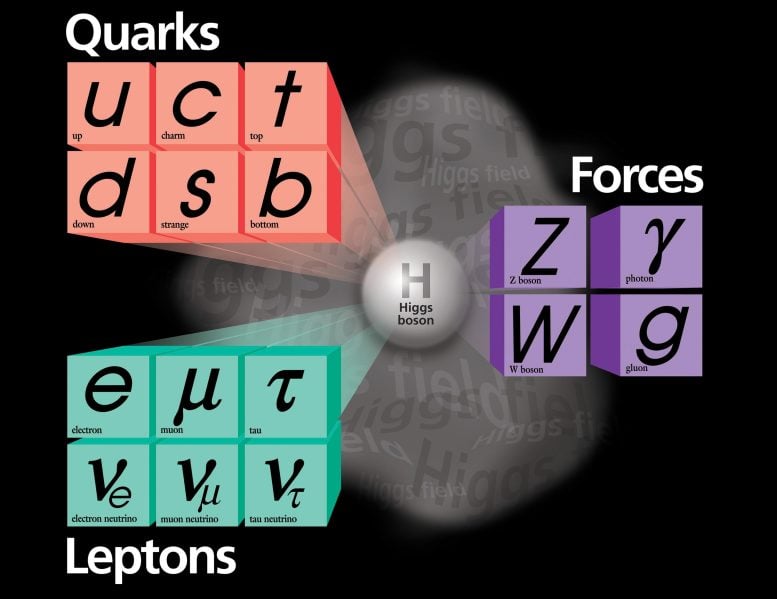
Boson W adalah partikel pembawa pesan dari gaya nuklir lemah. Hal ini bertanggung jawab untuk proses nuklir yang membuat matahari bersinar dan molekul peluruhan. Ilmuwan CDF sedang mempelajari sifat-sifat boson W menggunakan data yang mereka kumpulkan di Tevatron Collider di Fermilab. Kredit: Laboratorium Akselerator Nasional Fermi
Fisikawan CDF Chris Hayes dari[{” attribute=””>University of Oxford said, “The CDF measurement was performed over the course of many years, with the measured value hidden from the analyzers until the procedures were fully scrutinized. When we uncovered the value, it was a surprise.”
The mass of a W boson is about 80 times the mass of a proton, or approximately 80,000 MeV/c2. CDF researchers have worked on achieving increasingly more precise measurements of the W boson mass for more than 20 years. The central value and uncertainty of their latest mass measurement is 80,433 +/- 9 MeV/c2. This result uses the entire dataset collected from the Tevatron collider at Fermilab. It is based on the observation of 4.2 million W boson candidates, about four times the number used in the analysis the collaboration published in 2012.
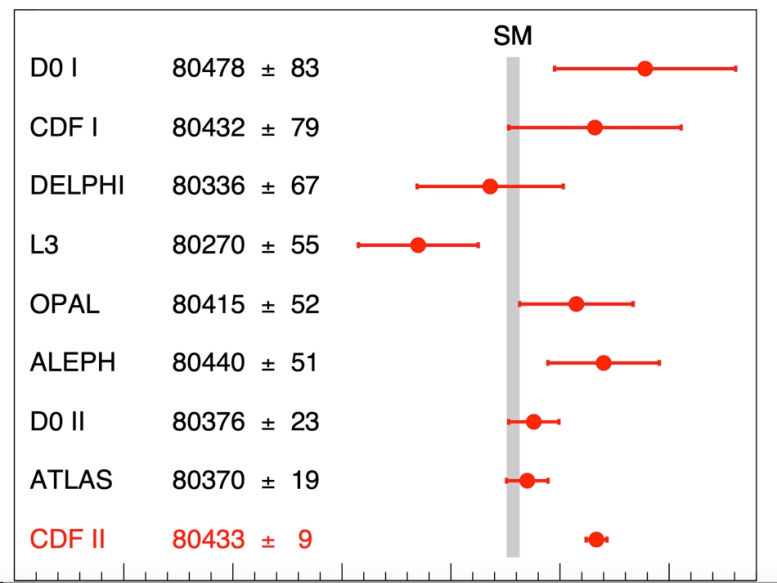
The mass of a W boson is about 80 times the mass of a proton, or approximately 80,000 MeV/c2. Scientists of the Collider Detector at Fermilab collaboration have achieved the world’s most precise measurement. The CDF value has a precision of 0.01 percent and is in agreement with many W boson mass measurements. It shows tension with the value expected based on the Standard Model of particle physics. The horizontal bars indicate the uncertainty of the measurements achieved by various experiments. The LHCb result was published after this paper was submitted and is 80354+- 32 MeV/c2. Credit: CDF collaboration
“Many collider experiments have produced measurements of the W boson mass over the last 40 years,” said CDF co-spokesperson Giorgio Chiarelli, Italian National Institute for Nuclear Physics (INFN-Pisa). “These are challenging, complicated measurements, and they have achieved ever more precision. It took us many years to go through all the details and the needed checks. It is our most robust measurement to date, and the discrepancy between the measured and expected values persists.”
The collaboration also compared their result to the best value expected for the W boson mass using the Standard Model, which is 80,357 ± 6 MeV/c2. This value is based on complex Standard Model calculations that intricately link the mass of the W boson to the measurements of the masses of two other particles: the top quark, discovered at the Tevatron collider at Fermilab in 1995, and the Higgs boson, discovered at the Large Hadron Collider at CERN in 2012.
CDF co-spokesperson David Toback, Texas A&M University, stated the result is an important contribution to testing the accuracy of the Standard Model. “It’s now up to the theoretical physics community and other experiments to follow up on this and shed light on this mystery,” he added. “If the difference between the experimental and expected value is due to some kind of new particle or subatomic interaction, which is one of the possibilities, there’s a good chance it’s something that could be discovered in future experiments.”
Reference: “High-precision measurement of the W boson mass with the CDF II detector” by CDF Collaboration, T. Aaltonen, S. Amerio, D. Amidei, A. Anastassov, A. Annovi, J. Antos, G. Apollinari, J. A. Appel, T. Arisawa, A. Artikov, J. Asaadi, W. Ashmanskas, B. Auerbach, A. Aurisano, F. Azfar, W. Badgett, T. Bae, A. Barbaro-Galtieri, V. E. Barnes, B. A. Barnett, P. Barria, P. Bartos, M. Bauce, F. Bedeschi, S. Behari, G. Bellettini, J. Bellinger, D. Benjamin, A. Beretvas, A. Bhatti, K. R. Bland, B. Blumenfeld, A. Bocci, A. Bodek, D. Bortoletto, J. Boudreau, A. Boveia, L. Brigliadori, C. Bromberg, E. Brucken, J. Budagov, H. S. Budd, K. Burkett, G. Busetto, P. Bussey, P. Butti, A. Buzatu, A. Calamba, S. Camarda, M. Campanelli, B. Carls, D. Carlsmith, R. Carosi, S. Carrillo, B. Casal, M. Casarsa, A. Castro, P. Catastini, D. Cauz, V. Cavaliere, A. Cerri, L. Cerrito, Y. C. Chen, M. Chertok, G. Chiarelli, G. Chlachidze, K. Cho, D. Chokheli, A. Clark, C. Clarke, M. E. Convery, J. Conway, M. Corbo, M. Cordelli, C. A. Cox, D. J. Cox, M. Cremonesi, D. Cruz, J. Cuevas, R. Culbertson, N. d’Ascenzo, M. Datta, P. de Barbaro, L. Demortier, M. Deninno, M. D’Errico, F. Devoto, A. Di Canto, B. Di Ruzza, J. R. Dittmann, S. Donati, M. D’Onofrio, M. Dorigo, A. Driutti, K. Ebina, R. Edgar, A. Elagin, R. Erbacher, S. Errede, B. Esham, S. Farrington, J. P. Fernández Ramos, R. Field, G. Flanagan, R. Forrest, M. Franklin, J. C. Freeman, H. Frisch, Y. Funakoshi, C. Galloni, A. F. Garfinkel, P. Garosi, H. Gerberich, E. Gerchtein, S. Giagu, V. Giakoumopoulou, K. Gibson, C. M. Ginsburg, N. Giokaris, P. Giromini, V. Glagolev, D. Glenzinski, M. Gold, D. Goldin, A. Golossanov, G. Gomez, G. Gomez-Ceballos, M. Goncharov, O. González López, I. Gorelov, A. T. Goshaw, K. Goulianos, E. Gramellini, C. Grosso-Pilcher, J. Guimaraes da Costa, S. R. Hahn, J. Y. Han, F. Happacher, K. Hara, M. Hare, R. F. Harr, T. Harrington-Taber, K. Hatakeyama, C. Hays, J. Heinrich, M. Herndon, A. Hocker, Z. Hong, W. Hopkins, S. Hou, R. E. Hughes, U. Husemann, M. Hussein, J. Huston, G. Introzzi, M. Iori, A. Ivanov, E. James, D. Jang, B. Jayatilaka, E. J. Jeon, S. Jindariani, M. Jones … P. Wagner, R. Wallny, S. M. Wang, D. Waters, W. C. Wester, D. Whiteson, A. B. Wicklund, S. Wilbur, H. H. Williams, J. S. Wilson, P. Wilson, B. L. Winer, P. Wittich, S. Wolbers, H. Wolfmeister, T. Wright, X. Wu, Z. Wu, K. Yamamoto, D. Yamato, T. Yang, U. K. Yang, Y. C. Yang, W.-M. Yao, G. P. Yeh, K. Yi, J. Yoh, K. Yorita, T. Yoshida, G. B. Yu, I. Yu, A. M. Zanetti, Y. Zeng, C. Zhou and S. Zucchelli, 7 April 2022, Science.
DOI: 10.1126/science.abk1781
The CDF collaboration comprises 400 scientists at 54 institutions in 23 countries.

“Gamer yang sangat menawan. Ahli web. Sarjana TV. Pecandu makanan. Ninja media sosial yang rajin. Pelopor musik hardcore.”

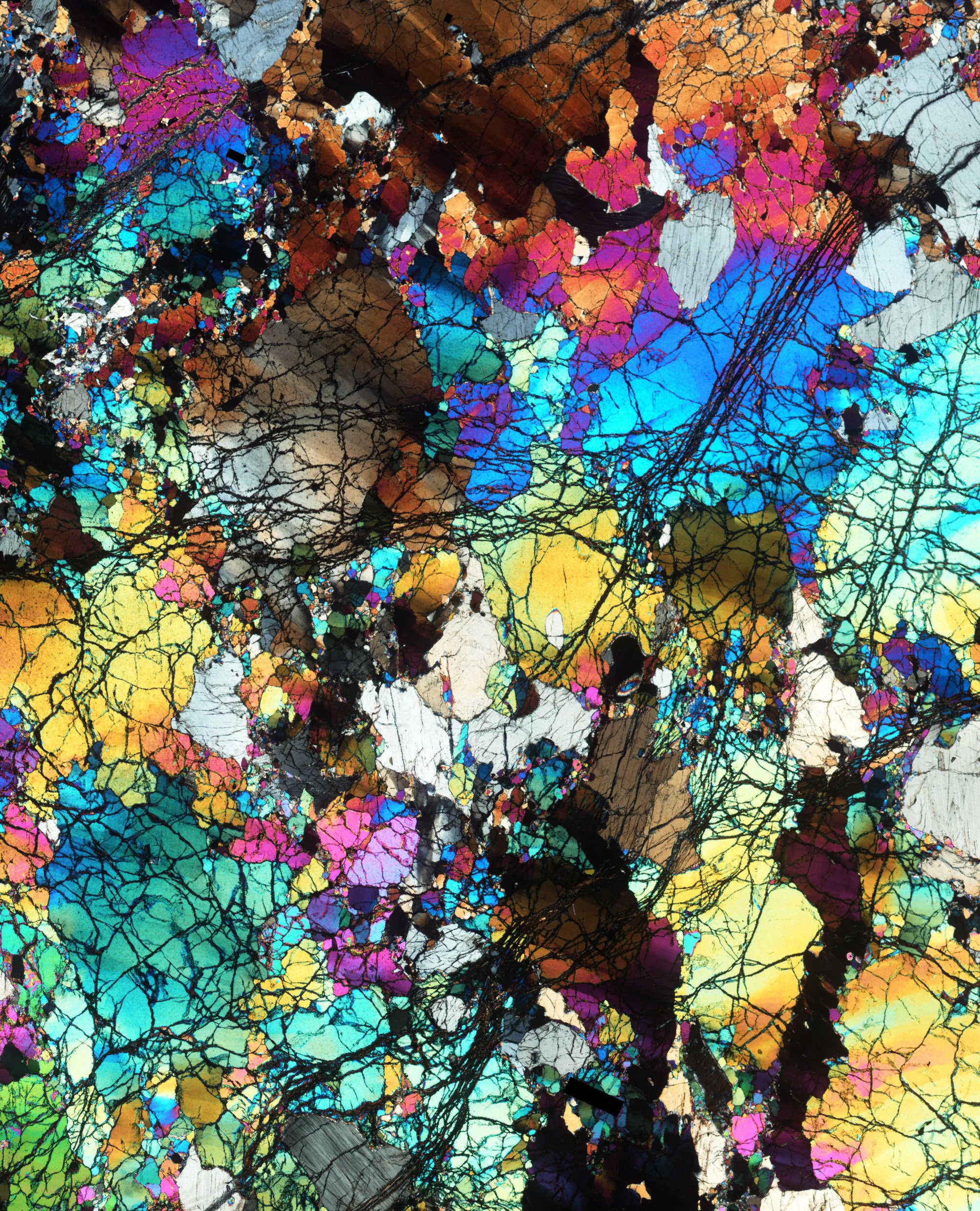

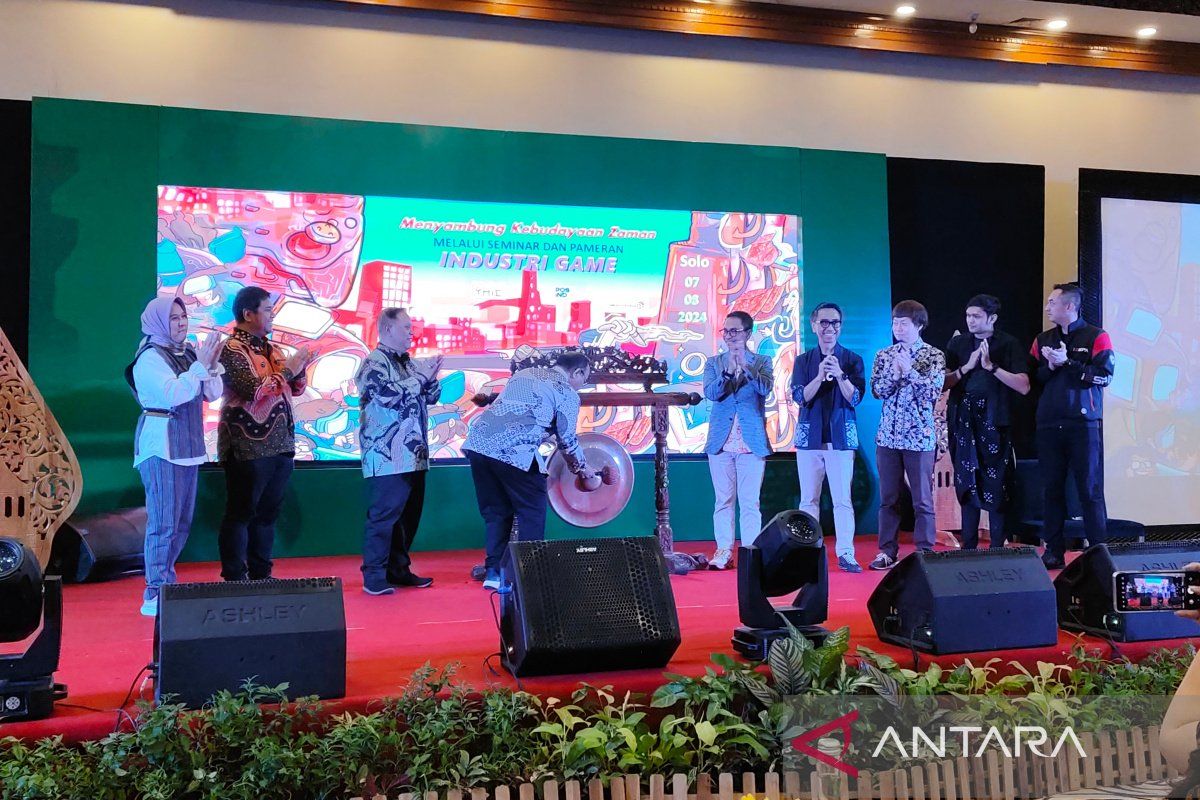


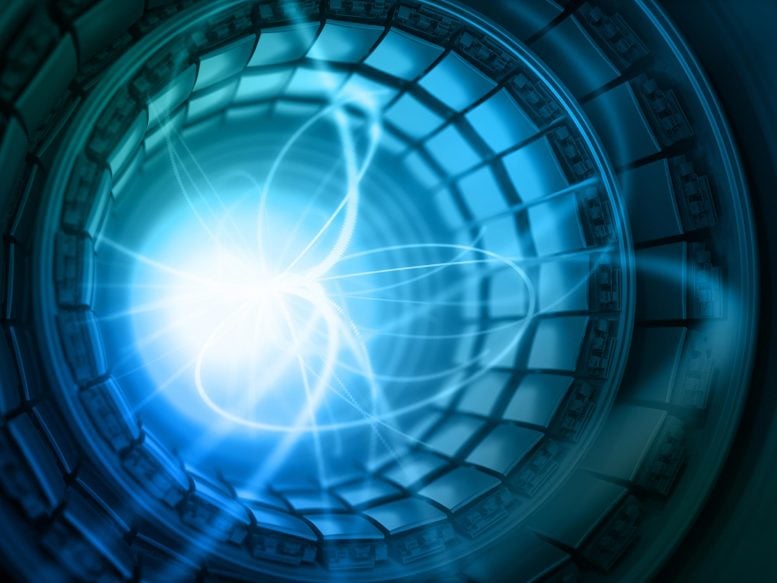
More Stories
Sebuah studi baru menantang teori oksidasi mantel
Generasi Milenial dan Generasi X menghadapi risiko lebih tinggi terkena 17 jenis kanker ini dibandingkan generasi baby boomer: ScienceAlert
Sebuah pencapaian penting bagi NASA dalam menemukan exoplanet